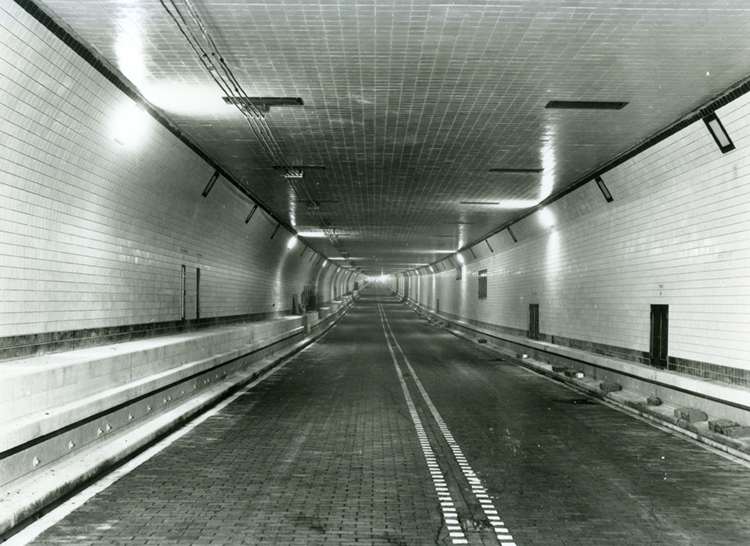On Dec. 22, 1937, 80 years ago today, the center tube of the Lincoln Tunnel opened to motor traffic, connecting midtown New York City with Weehawken, New Jersey. Funded by the the Public Works Administration (PWA), the tunnel was built beneath the Hudson River by the Port Authority of New York and New Jersey, putting thousands of people to work during the Great Depression. A terrific engineering feat, the tunnel eased commutes in the burgeoning metropolis. Named after Abraham Lincoln, the tunnel followed the completion of the Holland Tunnel, also under the Hudson, in 1927.
Construction on the Lincoln Tunnel began in March 1934, and crews worked from both sides of the Hudson River. The work of the sandhogs—as workers who dig tunnels are sometimes known—was dangerous and claustrophobic. To reach the construction sites beneath the river, crews had to pass through air locks that eased them in and out of the high pressure areas. Dynamite exploded, giant drills roared, and tram cars rattled as workers braced the tunnel’s excavation with concrete and hundreds of giant iron rings. The New Jersey and New York workers met beneath the river for the first time in August 1935.

Today, the Lincoln Tunnel has three tubes, each with two traffic lanes. The 8,216-foot (2,504-meter) center tube carries vehicles in either or both directions, depending on traffic needs. Westbound vehicles travel in the 7,482-foot (2,281-meter) north tube, opened in 1945. The 8,006-foot (2,440-meter) south tube is for eastbound traffic. The completion of the south tube of the Lincoln Tunnel in 1957 brought the total cost to about $190 million. More than 20 million vehicles use the tunnel every year. Today’s cash toll for using the bridge—$15 for cars—is slightly higher than the original fare of 50¢.
As late as 1900, Manhattan was not connected with New Jersey by either bridge or tunnel. A few bridges crossed the narrow Harlem River on the north, connecting Manhattan with the Bronx. Brooklyn Bridge, across the East River, connected the lower end of Manhattan with Long Island. But the thousands of New Jersey people who worked in Manhattan had to cross the Hudson River every day by ferryboat. This was the same method that the Dutch settlers had used nearly 300 years before. Today, seven tunnels under the Hudson River connect Manhattan with New Jersey. The tunnels are used for rail, automobile, truck, and bus traffic. Construction of other routes beneath the river is ongoing.
Untitled Document
Can't view the linked articles? Subscribe to World Book Online

World Book Online delivers a progressive sequence of core databases supported by supplemental
tools, such as language translation, graphic organizers, and unique Webquests. Moving from
Early World of Learning to World Book Advanced, World Book Online aligns end-users with their
appropriate learning levels. Each stand-alone site provides additional features to support the
needs of users’ specific capabilities.
The World Book Difference
World Book combines cutting-edge technology with traditional editorial excellence to produce
authoritative, trustworthy, and unbiased content. The digital content is updated in real time and
carefully curated for each learning level. Accessible 24/7, the content is available on a variety of devices.
World Book Online combines 21st-century instructional techniques with timely information.
By breaking down complex topics and using easily understandable text, World Book Online helps to
build fluency and increase comprehension. Featuring single sign-on capability, these sites are paired
with highly visual content to engage even the most reluctant reader. Our collection of resources kindles
a lifelong learning experience for every user. This adherence to clarity, currency, and accuracy makes
World Book’s digital offerings an information hub for the classroom, library, and beyond.
Image 1: Workers load rubble onto tram cars during the excavation of the Lincoln Tunnel in April 1935. Credit: The Port Authority of New York
Image 2: Temporary lighting illuminates the Lincoln Tunnel in October 1937, two months before it opened to motor traffic. Credit: The Port Authority of New York